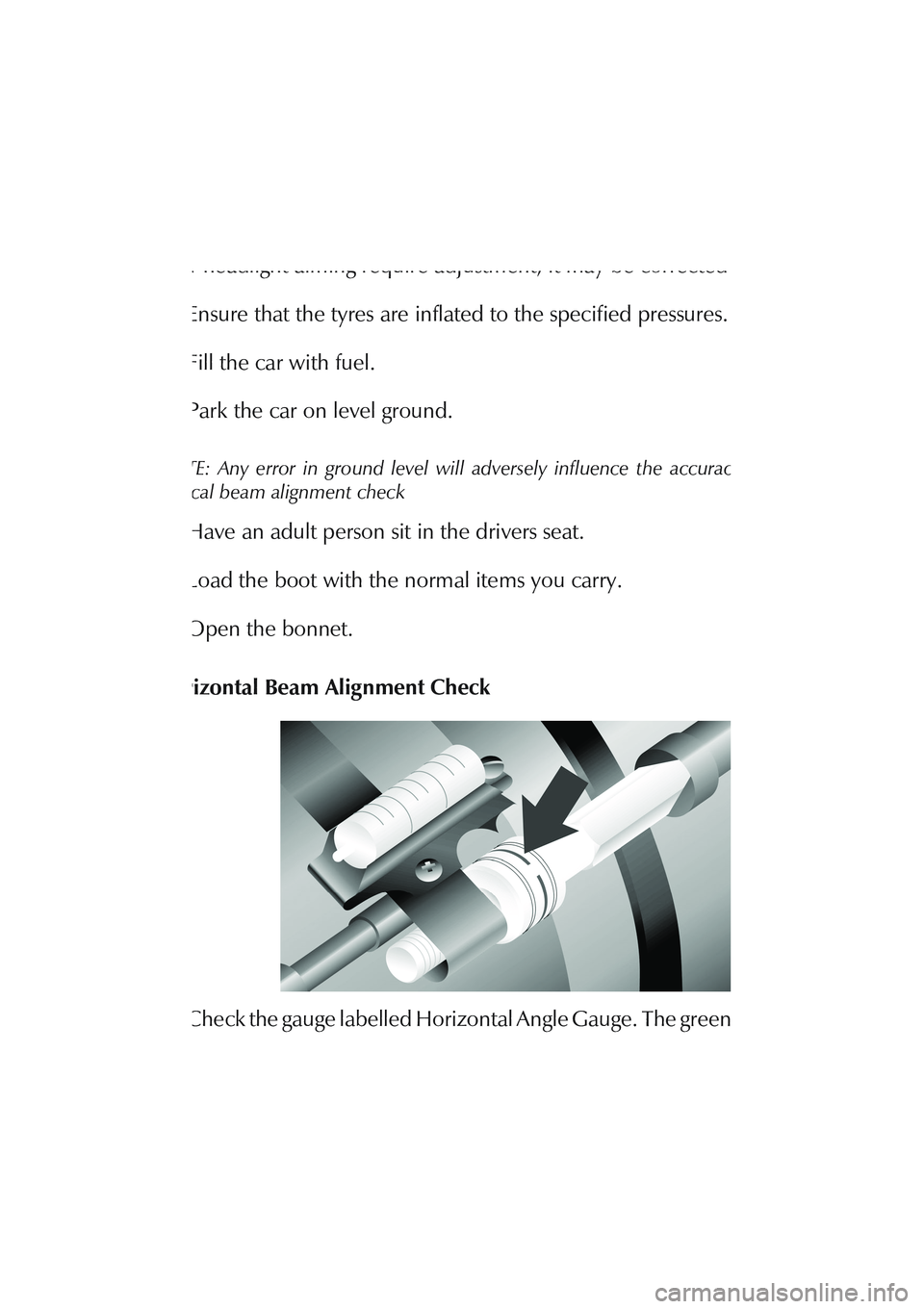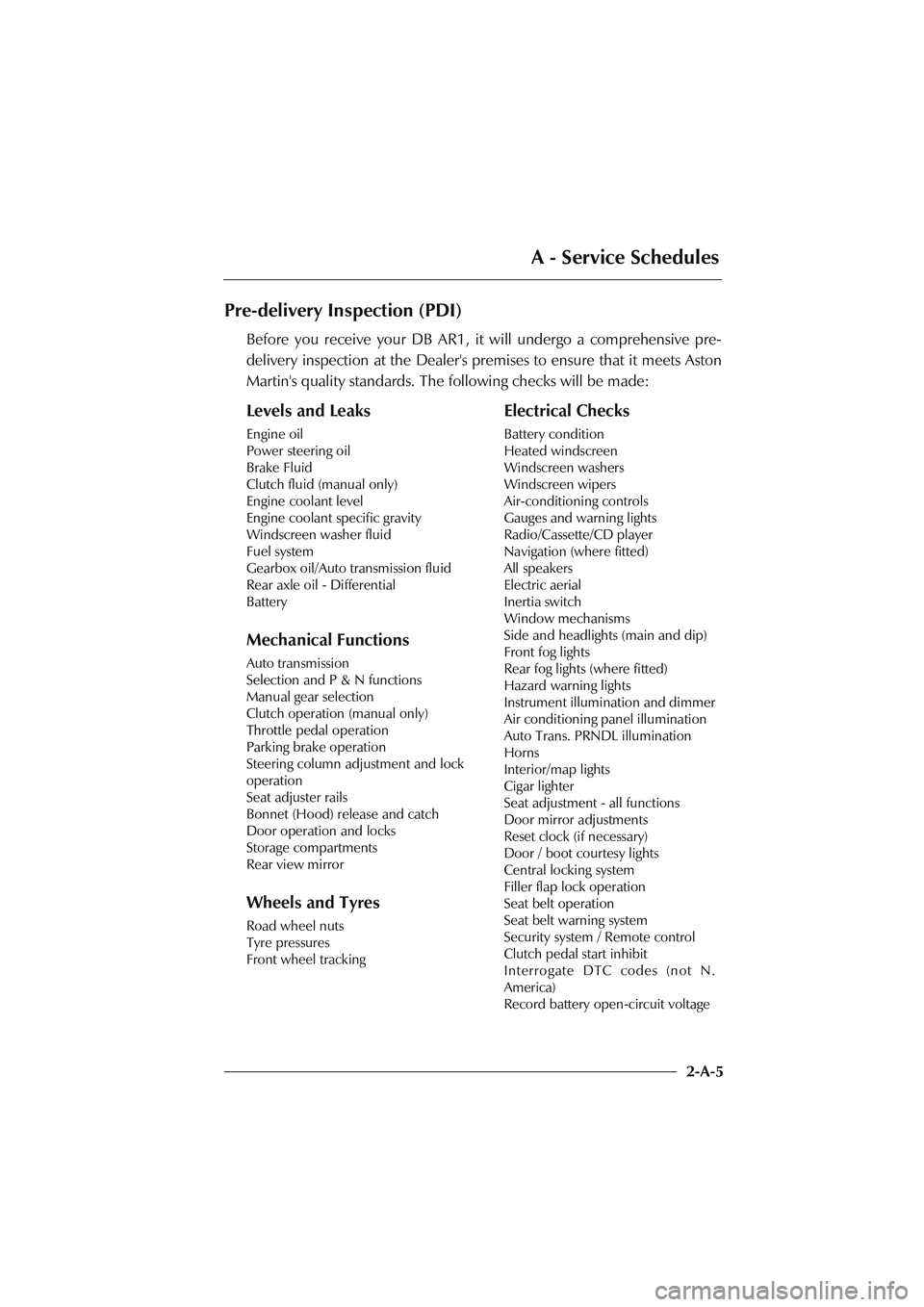open bonnet ASTON MARTIN DB AR1 Q 2003 Owners Guide
[x] Cancel search | Manufacturer: ASTON MARTIN, Model Year: 2003, Model line: DB AR1 Q, Model: ASTON MARTIN DB AR1 Q 2003Pages: 279, PDF Size: 3.77 MB
Page 16 of 279

A - Before Driving
1-A-4
Unlocking the Car / Turning off the Alarm
To unlock the car and turn the alarm system off, approach to within 10
metres (30 feet) of the car and point the key fob towards the rear window.
Press the left button on the alarm key fob.
The exterior direction indicators flash three times, indicating that the alarm
has been switched off. At the same time, the central locking system unlocks
the car doors and fuel filler flap. Alarm sensing on the boot lock is also
switched off so that the boot may be opened without triggering the alarm.
Locking the Car / Turning on the Alarm
To turn the alarm system on and lock the car, stand within 10 metres (30 feet)
of the car and point the key fob towards the rear window. Press the left
button on the alarm key fob.
The direction indicators flash once as the alarm is switched on. Alarm
sensing is then operative on the door locks, bonnet and boot. At the same
time, the car doors, boot and filler flap are locked by the central locking
system.
Engine Immobiliser
The engine is immobilised by the Passive Anti-Theft System (PATS) and may
not be started until a correctly coded key is inserted and turned in the
ignition switch (See 'Security Systems' for a full description of PATS). The
PATS system is fully automatic and requires no intervention from the driver.
Page 59 of 279

B - Controls
1-B-23
Bonnet (Hood) and Boot (Trunk)
Bonnet (Hood) Release
The bonnet release lever is situated
on the outside of the left hand front
footwell. Pull the lever to release the
bonnet latches. The bonnet will be
released and will rise until captured
by the bonnet safety catch.
Bonnet (Hood) Safety Catch
The bonnet safety catch is located under the
bonnet rear edge on the drivers side of the car
(left side on left hand drive, right side on right
hand drive).
Push down slightly on the bonnet rear edge
whilst pushing forward on the bonnet safety
catch to release it. Lift the bonnet until fully
open. The bonnet is held open by two gas
struts.
Page 60 of 279

B - Controls
1-B-24
Closing the Bonnet (Hood)
To close the bonnet, hold near the centre of the rear edge and lower until
approximately 18 inches (450 mm) from the latch mechanisms and then
release it. After closing the bonnet, ensure that both left and right hand
latches have fully engaged by pulling up at either side of the bonnet rear
edge.
WARNING: Before closing the bonnet, ensure that no one is obstructing the
closing area and that hands and clothing are clear. Remove tools, cleaning cloths,
etc. from the engine compartment.
Boot (Trunk) Release
There are four methods for opening the boot.
1. The boot lid may be released at any time using the right hand button on
the key fob.
ASTON MARTIN
Page 103 of 279

E - Security Systems
1-E-4
Unlocking the Car, Disarming the Alarm
Point the key fob towards the rear window and press the left button once.
The following events will occur:
1. The green light on the key fob will light while the left button is pressed.
2. The car doors and fuel filler flap will unlock.
3. The direction indicators will flash (in markets where visible alarm signals
are permitted and programmed).
4. The alarm system will be switched off.
Locking the Car, Arming the Alarm
Point the key fob towards the rear window and press the left button. The
following events will occur:
1. The green light on the key fob will light while the left button is pressed.
2. The car doors and fuel filler flap will lock.
3. The direction indicators will flash once (in markets where visible alarm
signals are permitted).
4. The alarm system will be switched on.
Alarm and Security System Protection
With the alarm system armed, any attempt to open a door, the boot or the
bonnet will result in full alarm activation.
(See also the engine immobilisation protection afforded by the PATs system)
Page 113 of 279

F - Owner Maintenance
1-F-4
Servicing Precautions
To avoid personal injury, the following safety precautions must be observed
when the bonnet is open and the engine is running or the ignition is switched
on.
WARNINGS:
Keep hands, hair, tools, items of clothing and jewellery clear of all drive belts,
pulleys and operating mechanisms. The cooling fans may operate even though
the engine is not running. The windscreen wiper mechanism is fitted with an
intermittent delay facility and may operate unexpectedly if left switched on.
Carbon monoxide is a dangerous gas and can cause unconsciousness and may be
fatal. Do not breathe exhaust gas as it contains carbon monoxide which by itself
has no colour or odour. Never start or leave the engine running in an enclosed,
unventilated area.
Avoid skin contact with all exhaust system and engine components, engine fluids
and escaping steam. They may be hot and will burn you.
Whenever possible work in the engine compartment with the engine cool, the
ignition switched off and the battery disconnected.
Do not work beneath the car with the vehicle lifting jack as the only support.
Place suitable stands under the car.
Keep children and pets clear of the car. Do not allow anyone inside the car unless
specifically working to your instructions.
Page 154 of 279

F - Owner Maintenance
1-F-45
On Board Headlight Aiming (where fitted)
The headlight assemblies (main and dipped beam lights) are factory set to
give correct forward illumination under average load conditions. Should
your headlight aiming require adjustment, it may be corrected as follows:
1. Ensure that the tyres are inflated to the specified pressures.
2. Fill the car with fuel.
3. Park the car on level ground.
NOTE: Any error in ground level will adversely influence the accuracy of the
vertical beam alignment check
4. Have an adult person sit in the drivers seat.
5. Load the boot with the normal items you carry.
6. Open the bonnet.
Horizontal Beam Alignment Check
1. Check the gauge labelled Horizontal Angle Gauge. The green line on the
collar must be aligned with the pointer at the side of the spirit level. If
adjustment is required, rotate the screw and collar until the green line
is aligned with the pointer.
Page 190 of 279

2-A-5
A - Service Schedules
Pre-delivery Inspection (PDI)
Before you receive your DB AR1, it will undergo a comprehensive pre-
delivery inspection at the Dealer's premises to ensure that it meets Aston
Martin's quality standards. The following checks will be made:
Levels and Leaks
Engine oil
Power steering oil
Brake Fluid
Clutch fluid (manual only)
Engine coolant level
Engine coolant specific gravity
Windscreen washer fluid
Fuel system
Gearbox oil/Auto transmission fluid
Rear axle oil - Differential
Battery
Mechanical Functions
Auto transmission
Selection and P & N functions
Manual gear selection
Clutch operation (manual only)
Throttle pedal operation
Parking brake operation
Steering column adjustment and lock
operation
Seat adjuster rails
Bonnet (Hood) release and catch
Door operation and locks
Storage compartments
Rear view mirror
Wheels and Tyres
Road wheel nuts
Tyre pressures
Front wheel tracking
Electrical Checks
Battery condition
Heated windscreen
Windscreen washers
Windscreen wipers
Air-conditioning controls
Gauges and warning lights
Radio/Cassette/CD player
Navigation (where fitted)
All speakers
Electric aerial
Inertia switch
Window mechanisms
Side and headlights (main and dip)
Front fog lights
Rear fog lights (where fitted)
Hazard warning lights
Instrument illumination and dimmer
Air conditioning panel illumination
Auto Trans. PRNDL illumination
Horns
Interior/map lights
Cigar lighter
Seat adjustment - all functions
Door mirror adjustments
Reset clock (if necessary)
Door / boot courtesy lights
Central locking system
Filler flap lock operation
Seat belt operation
Seat belt warning system
Security system / Remote control
Clutch pedal start inhibit
Interrogate DTC codes (not N.
America)
Record battery open-circuit voltage